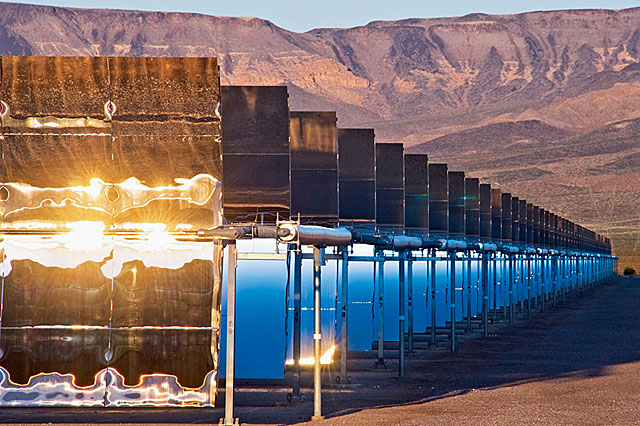sierraclub.org - sierra magazine - nov/dec 2011 - a matter of survival - november/december 2011 - sierra magazine - sierra club
How big solar plants can save the planet without killing this desert tortoise
By Nate Seltenrich
 John Agnew/Vanishing Circles
John Agnew/Vanishing Circles
With a population of 200, the desolate Southern California hamlet of Desert Center, founded in 1921 by a stranded motorist, has seen better days. Yet change is coming, and with it a drama that illuminates a fundamental dilemma: Can we humans find redemption by generating enough clean energy—quickly—to replace the filthy old energy sources that are wreaking havoc on landscapes and species, our own included?
Six miles north of Desert Center, near the edge of Joshua Tree National Park in the Chuckawalla Valley, the largest photovoltaic solar plant ever approved on public land is beginning to shimmer mirage-like on the horizon.
A few decades back, any environmentalist worth his or her Vibram soles would have been unequivocal in condemning all desert development. Climate disruption has changed that. Nationwide, the country still gets 45 percent of its energy from coal. With it come vast quantities of mercury that waft through the air, ending up in our seafood, and particulates that are causing unprecedented asthma rates. (See "This Much Mercury . . .") Worse, coal is the single largest contributor of the toxic greenhouse gases that are making our climate go haywire.
Fallow farmland and parcels degraded by mining and pollution—so-called brownfield sites—are ideal for solar plants.
"The whole life cycle of coal is destructive," says Vanessa Pierce, deputy director of the Sierra Club's Beyond Coal campaign. Every watt of new energy produced by a non-coal source, she adds, is a boon to our species—and other species.
When Tempe, Arizona's First Solar completes its Desert Sunlight plant on Bureau of Land Management (BLM) property near Joshua Tree in late 2013, it will power more than 160,000 homes at peak hours.
Like virtually any large-scale solution to the dirty-power dilemma, the 6.9-square-mile facility is not without its costs—in this case, costs that will be incurred by desert tortoises and other animals and plants. Big solar installations, after all, require lots of land, large-scale machinery, broad dirt roads, and hulking arrays mounted on metal pillars or concrete pads. Even the lowest-impact designs alter the landscape and potentially disturb habitat for creatures like bighorn sheep, Mojave ground squirrels, kit foxes, and those reclusive tortoises, which spend as much as 95 percent of their lives in underground burrows.
The Sierra Club and other environmental groups worked for more than two years to make the costs to wildlife as low as possible at the Desert Sunlight site. In the end, they convinced FirstSolar and the BLM to agree to a raft of modifications. The company removed 136 acres from the project to accommodate the tortoises, a threatened species. It agreed to replant native vegetation and to protect nearly 23 square miles of adjacent lands from development, including renewable-energy development.
 Nevada Solar One, a solar-thermal power plant in Boulder City, Nevada. As of August, the Department of the Interior had approved 12 large-scale solar projects in 18 months.| David Nunuk/All Canada Photos/Photolibrary
Nevada Solar One, a solar-thermal power plant in Boulder City, Nevada. As of August, the Department of the Interior had approved 12 large-scale solar projects in 18 months.| David Nunuk/All Canada Photos/Photolibrary
"That's a huge gain," says Barbara Boyle, Beyond Coal's senior representative. "It's a good example of a developer working to minimize the impacts." Boyle and other Sierra Club leaders are encouraging developers and public agencies to reduce environmental harm from the get-go rather than trying to limit damage once a project has been submitted for government approval. They are strongly urging developers and the officials who are entrusted with protecting the public and its lands to site large solar, wind, and geothermal facilities only on land that is already degraded or whose value as habitat is not unique or irreplaceable.
Some renewable-energy projects, despite their overall advantages for public health and the climate, are just too poorly conceived, too destructive to land and wildlife, to earn environmentalists' support. But environmentalists want new clean-energy sources. Rooftop solar and ardent energy conservation, along with large-scale solar, wind, and geothermal projects, must be a part of the nation's energy future. Rooftop solar systems on homes and office buildings will play a pivotal role in replacing dirty energy in the coming years, Boyle says, but such small-scale projects (known as "distributed generation") can't be developed fast enough to meet the country's demand for clean energy.
With that in mind, the Club helped cook up "smart from the start." This principle, embraced by the Obama administration, encourages environmental groups to work with large-scale renewable-energy developers rather than against them. "There's momentum developing to get this right," says Bill Corcoran, Beyond Coal's Western director.
California's ambitious Renewables Portfolio Standard calls for utilities to purchase a third of their power from renewable sources by 2020; currently 20 percent comes from renewables. Similar targets exist throughout the West, including in Washington (15 percent by 2020), Arizona (15 percent by 2025), Utah (20 percent by 2025), and Oregon (25 percent by 2025). New York's standard is even tougher, calling for 30 percent of its energy to come from renewables by 2015.
These benchmarks are ambitious. At the end of 2010, the entire country had just 1,000 megawatts of solar energy installed. California's standard demands the generation of an estimated 17,000 megawatts of power from renewable sources by 2020. In 2010, the California Energy Commission approved nine solar-thermal power plants for 4,142 megawatts: 25 percent of the state goal through a single technology in just one year. A massive plant planned for completion in 2013 outside Blythe, California—only 40 miles east of Desert Center—will produce 968 megawatts.
In partnership with the Department of the Interior and the Department of Energy, the BLM is developing a document, to be finalized as early as 2012, that will direct solar development toward 24 zones in Arizona, California, Colorado, Nevada, New Mexico, and Utah, all handpicked for their sunlight, proximity to transmission lines, and absence of designated conservation areas. The BLM's existing policy was revised in January to steer solar developers away from environmentally sensitive (a.k.a. "high-conflict") sites throughout the West.
Similarly, the EPA is identifying lands degraded by mining, industry, or pollution—so-called brownfield sites—that may be suitable for solar plants. In Arizona, the BLM is working with the Sierra Club's Grand Canyon Chapter to identify such sites for potential development. By proposing to build their facility on land near existing high-voltage transmission lines, with 4,300 acres preserved as foraging habitat for the Swainson's hawk, developers of a 650-megawatt solar facility in California's Antelope Valley won Sierra Club support. And in the state's agriculture-rich Central Valley, a joint effort is under way between farmers and the Westlands Water District to permit solar plants producing as many as 5,000 megawatts on fallow, selenium-contaminated farmlands.
"This is about as low-resource-conflict as you're going to find in California," says Helen O'Shea, deputy director of the Natural Resources Defense Council's Western Renewable Energy Project. Energy companies from tiny Cool Earth Solar to world leader SunPower are looking to site new projects on unused farmlands up and down the Central Valley.
Elsewhere in the Southwest, the Black Mesa Water Coalition is pushing to develop solar power on the site of a former Arizona coal mine. And the Moapa Band of Paiutes in southwestern Nevada is building a 350-megawatt solar facility on lands contaminated for decades by a coal-fired plant. The Sierra Club is working with Indian tribes in both states to advocate for large-scale renewable energy on degraded lands that can displace the dirty energy generated at nearby coal plants.
For their part, solar companies are doing more up-front investigation of potential sites and are meeting with locals and environmental and cultural organizations sooner in the planning process. "The companies are becoming educated," says Kim Delfino, California program director for Defenders of Wildlife. BrightSource, which faced a sandstorm of controversy over its giant Ivanpah solar-thermal plant in the California desert, plans to site its next big project on private land outside Las Vegas that was previously slated for residential development, diminishing the potential for environmental conflicts.
Large-scale wind energy is an important part of the renewables mix, but it too has downsides—bird kills, noise, and disruption of scenic views—that environmentalists are fighting to minimize. Sparked by federal incentives that expire next year, huge wind farms are in development throughout Oregon, Nevada, Wyoming, and California. Concurrently, offshore wind turbines—which are more efficient than land-based ones because of more consistent ocean winds—are being explored in the Great Lakes and off the Atlantic coast.
The wind industry already employs more people than the coal mining industry in the United States, Beyond Coal's Vanessa Pierce says, and the cost of wind energy is almost unbeatable: 3 cents per kilowatt-hour versus an average of 4 cents for coal. This has helped make wind energy the fastest-growing source of power on the planet. The Department of Energy estimates that nationwide we'll receive 20 percent of our power from wind by 2030. The state of Iowa already does.
Just as marquee species like the desert tortoise and the Mojave ground squirrel weigh on environmentalists' consciences as they strive to say yes to solar development, raptors, seabirds, and songbirds worry groups wrestling with the questions of when and where to support the development of wind farms. In Southern California, for example, as many as nine planned wind plants in Tehachapi and on nearby mountain passes could threaten native golden eagles, says Lisa Belenky, a senior attorney with the Center for Biological Diversity. The Sierra Club has weighed in on federal guidelines to improve wind projects built on land and off the coast, urging protection even for animals not covered by endangered species laws.
Beyond Coal's Bill Corcoran, for one, is encouraged. "There is better understanding at the federal decision level about the primary importance of getting planning right and embracing the principles of smart from the start," he says. "As we continue down that path, I predict that there will be far fewer conflicts than there have been in the past."
Neither tortoises nor golden eagles can fully know about the threats that humans have subjected them to—be they the mass extinction that climate disruption portends or the immediate risks of whirring turbine blades or the construction of solar arrays in their habitat. As we struggle to clean up the mess a fossil-fuel-driven economy has created, the trick will be to balance the practical, ethical, and existential ambiguities that affect all species.
Nate Seltenrich is an outdoor and environmental writer based in Oakland, California.
This article was funded by the Sierra Club's Beyond Coal campaign.
This article has been corrected.